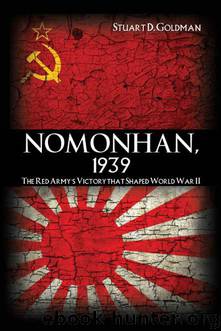Nomonhan, 1939: The Red Army's Victory That Shaped World War II by Stuart D. Goldman

Author:Stuart D. Goldman
Language: eng
Format: mobi, epub
Tags: Non-Fiction, Retail, Eurasian History, Asian History, Military History, 20th Century, European History, 21st Century, v.5, China, Political Science, Japan, Military Science, Russia, History
ISBN: 9781591143291
Publisher: Naval Institute Press
Published: 2012-04-14T15:00:00+00:00
Map 5. July 1–3 Japanese Offensive
On the night of July 1, as Soviet reinforcements were being brought up, Komatsubara began the first phase of his attack. His 23rd Division, together with the Yasuoka Detachment, converged on Fui Heights, just east of the Halha River, some eleven miles north of its confluence with the Holsten. The designation “heights” in this case is misleading. A Japanese infantry colonel described Fui as a “raised pancake” about one to one-and-a-half miles across, some thirty to forty feet higher than the surrounding terrain. For some still-unexplained reason, the small Soviet force that had been stationed on the heights was withdrawn during the day on July 1. That night, Fui Heights was occupied by Komatsubara’s forces almost without opposition.35 This caused no great stir at Zhukov’s headquarters. Komatsubara bided his time through the day on July 2.
On the night of July 2–3, the Japanese achieved a brilliant tactical success. A battalion of the 71st Infantry Regiment rowed silently across the Halha River on the moonless night and made an unopposed landing on the west bank opposite Fui Heights. Recent rains had swollen the river to 100–150 yards wide and about six feet deep, too much for men, horses, or vehicles to ford. As planned, combat engineers worked swiftly through the night and spanned the river with a pontoon bridge, which connected a natural track on the right shore with a dirt road on the left. The bridge was completed by 6:30 a.m. July 3 and the main body of Komatsubara’s 71st and 72nd Infantry Regiments (23rd Division) and 26th Regiment (7th Division), began a slow and arduous crossing. The pontoon bridge was a flimsy affair less than eight feet wide, a natural bottleneck. Only one truck at a time could cross, and each one had to be guided carefully because of the narrowness of the span. Unfortunately for the attackers, the bridge could not bear the weight of armored vehicles, so they had to proceed without tank support. At least they were able to carry across their regimental artillery—dismantled and packed on horses, then reassembled on the west bank—consisting of eighteen 37-mm antitank guns, twelve 75-mm mountain guns, eight 75-mm field guns, and four 120-mm howitzers. The crossing took a full day. They were fortunate indeed to have been unmolested by the enemy.
The thrust across the Halha was commanded personally by General Komatsubara, who was accompanied by several Kwantung Army staff officers, including the deputy chief of staff, General Yano, and Colonel Hattori and Major Tsuji from the Operations Section. Still no Soviet/MPR scouts or reconnaissance planes had detected the crossing.
Even though the big Japanese air raid had put Zhukov on his guard, the initial Japanese moves of July 1–3 achieved complete tactical surprise and found the Soviet-MPR forces in a vulnerable position. This was due, in no small part, to the boldness of Tsuji’s operational plan. The first indication the Soviets had that a major Japanese offensive had begun came in the predawn hours of July 3, when General Yasuoka’s tanks attacked.
Download
Nomonhan, 1939: The Red Army's Victory That Shaped World War II by Stuart D. Goldman.epub
This site does not store any files on its server. We only index and link to content provided by other sites. Please contact the content providers to delete copyright contents if any and email us, we'll remove relevant links or contents immediately.
| Africa | Americas |
| Arctic & Antarctica | Asia |
| Australia & Oceania | Europe |
| Middle East | Russia |
| United States | World |
| Ancient Civilizations | Military |
| Historical Study & Educational Resources |
The Radium Girls by Kate Moore(11627)
100 Deadly Skills by Clint Emerson(4695)
The Templars by Dan Jones(4561)
Rise and Kill First by Ronen Bergman(4549)
The Doomsday Machine by Daniel Ellsberg(4250)
The Rape of Nanking by Iris Chang(4024)
Killing England by Bill O'Reilly(3899)
Hitler in Los Angeles by Steven J. Ross(3803)
Stalin by Stephen Kotkin(3730)
12 Strong by Doug Stanton(3420)
Hitler's Monsters by Eric Kurlander(3166)
Blood and Sand by Alex Von Tunzelmann(3060)
Darkest Hour by Anthony McCarten(3019)
The Code Book by Simon Singh(2864)
The Art of War Visualized by Jessica Hagy(2844)
Hitler's Flying Saucers: A Guide to German Flying Discs of the Second World War by Stevens Henry(2625)
Babylon's Ark by Lawrence Anthony(2434)
The Second World Wars by Victor Davis Hanson(2423)
Tobruk by Peter Fitzsimons(2376)
